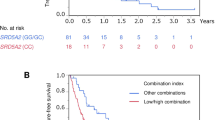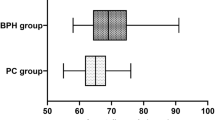Abstract
Background:
Fatty-acid synthase (FASN), selectively overexpressed in prostate cancer (PCa) cells, has been described as linked to the aggressiveness of PCa. Constitutional genetic variation of the FASN gene and the expression levels of FASN protein in cancer cells could thus be expected to predict outcome after radical prostatectomy (RP). This study evaluates the associations of malignant tissue status, neoadjuvant androgen deprivation therapy (NADT) and single-nucleotide polymorphisms (SNPs) of FASN with FASN protein expression in prostate tissue. The study then examines the associations of FASN SNPs and gene expression with three measures of post-prostatectomy outcome.
Methods:
Seven tagging FASN SNPs were genotyped in 659 European American men who underwent RP at Roswell Park Cancer Institute between 1993 and 2005. FASN protein expression was assessed using immunohistochemistry. The patients were followed for an average of 6.9 years (range: 0.1–20.6 years). Outcome was assessed using three end points: biochemical failure, treatment failure and development of distant metastatic PCa. Cox proportional hazards analyses were used to evaluate the associations of the tagging SNPs and FASN expression with these end points. Bivariate associations with outcomes were considered; the associations also were controlled for known aggressiveness indicators.
Results:
Overall, no SNPs were associated with any known aggressiveness indicators. FASN staining intensity was stronger in malignant than in benign tissue, and NADT was associated with decreased FASN staining in both benign and malignant tissue. The relationships of FASN SNPs and staining intensity with outcome were less clear. One SNP, rs4246444, showed a weak association with outcome. FASN staining intensity also showed a weak and seemingly contradictory relationship with outcome.
Conclusions:
Additional study with longer follow-up and populations that include more metastatic patients is warranted.
This is a preview of subscription content, access via your institution
Access options
Subscribe to this journal
Receive 4 print issues and online access
$259.00 per year
only $64.75 per issue
Buy this article
- Purchase on Springer Link
- Instant access to full article PDF
Prices may be subject to local taxes which are calculated during checkout

Similar content being viewed by others
References
Cancer Facts & Figures 2014. American Cancer Society: Atlanta, GA, USA, 2014.
Loberg RD, Mehra R, Pienta KJ, Taichman RS . The evolving biology and treatment of prostate cancer. J Clin Invest 2007; 117: 2351+.
Brawley OW, Ankerst DP, Thompson IM . Screening for prostate cancer. CA Cancer J Clin 2009; 59: 264–273.
Thompson IM, Lucia MS . Diagnosing prostate cancer: through a glass, darkly. J Urol 2006; 175: 1598–1599.
Scardino PT . Natural history and treatment of early stage prostate cancer. Trans Am Clin Climatol Assoc 2000; 111: 201–241.
Myers RB, Oelschlager DK, Weiss HL, Frost AR, Grizzle WE . Fatty acid synthase: an early molecular marker of progression of prostatic adenocarcinoma to androgen independence. J Urol 2001; 165: 1027–1032.
Pizer ES, Pflug BR, Bova GS, Han WF, Udan MS, Nelson JB . Increased fatty acid synthase as a therapeutic target in androgen-independent prostate cancer progression. Prostate 2001; 47: 102–110.
Rossi S, Graner E, Febbo P, Weinstein L, Bhattacharya N, Onody T et al. Fatty acid synthase expression defines distinct molecular signatures in prostate cancer. Mol Cancer Res 2003; 1: 707–715.
Swinnen JV, Roskams T, Joniau S, Van Poppel H, Oyen R, Baert L et al. Overexpression of fatty acid synthase is an early and common event in the development of prostate cancer. Int J Cancer 2002; 98: 19–22.
Menendez JA, Lupu R . Fatty acid synthase and the lipogenic phenotype in cancer pathogenesis. Nat Rev Cancer 2007; 7: 763–777.
Ogino S, Nosho K, Meyerhardt JA, Kirkner GJ, Chan AT, Kawasaki T et al. Cohort study of fatty acid synthase expression and patient survival in colon cancer. J Clin Oncol 2008; 26: 5713–5720.
Shurbaji MS, Kalbfleisch JH, Thurmond TS . Immunohistochemical detection of a fatty acid synthase (OA-519) as a predictor of progression of prostate cancer. Hum Pathol 1996; 27: 917–921.
Jiang B, Li EH, Lu YY, Jiang Q, Cui D, Jing YF et al. Inhibition of Fatty-acid Synthase Suppresses P-AKT and Induces Apoptosis in Bladder Cancer. Urology 2012; 80: 484, e489–484, e415.
Alo PL, Amini M, Piro F, Pizzuti L, Sebastiani V, Botti C et al. Immunohistochemical expression and prognostic significance of fatty acid synthase in pancreatic carcinoma. Anticancer Res 2007; 27: 2523–2527.
Sebastiani V, Botti C, Di Tondo U, Visca P, Pizzuti L, Santeusanio G et al. Tissue microarray analysis of FAS, Bcl-2, Bcl-x, ER, PgR, Hsp60, p53 and Her2-neu in breast carcinoma. Anticancer Res 2006; 26: 2983–2987.
Sebastiani V, Visca P, Botti C, Santeusanio G, Galati GM, Piccini V et al. Fatty acid synthase is a marker of increased risk of recurrence in endometrial carcinoma. Gynecol Oncol 2004; 92: 101–105.
Visca P, Sebastiani V, Botti C, Diodoro MG, Lasagni RP, Romagnoli F et al. Fatty acid synthase (FAS) is a marker of increased risk of recurrence in lung carcinoma. Anticancer Res 2004; 24: 4169–4173.
Kuhajda FP, Jenner K, Wood FD, Hennigar RA, Jacobs LB, Dick JD et al. Fatty acid synthesis: a potential selective target for antineoplastic therapy. Proc Natl Acad Sci USA 1994; 91: 6379–6383.
Swinnen JV, Van Veldhoven PP, Timmermans L, De Schrijver E, Brusselmans K, Vanderhoydonc F et al. Fatty acid synthase drives the synthesis of phospholipids partitioning into detergent-resistant membrane microdomains. Biochem Biophys Res Commun 2003; 302: 898–903.
Fiorentino M, Zadra G, Palescandolo E, Fedele G, Bailey D, Fiore C et al. Overexpression of fatty acid synthase is associated with palmitoylation of Wnt1 and cytoplasmic stabilization of beta-catenin in prostate cancer. Lab Invest 2008; 88: 1340–1348.
Flavin R, Zadra G, Loda M . Metabolic alterations and targeted therapies in prostate cancer. J Pathol 2011; 223: 283–294.
Komekado H, Yamamoto H, Chiba T, Kikuchi A . Glycosylation and palmitoylation of Wnt-3a are coupled to produce an active form of Wnt-3a. Genes Cells 2007; 12: 521–534.
Lichtenstein P, Holm NV, Verkasalo PK, Iliadou A, Kaprio J, Koskenvuo M et al. Environmental and heritable factors in the causation of cancer — analyses of cohorts of twins from Sweden, Denmark, and Finland. N Engl J Med 2000; 343: 78–85.
Hjelmborg JB, Scheike T, Holst K, Skytthe A, Penney KL, Graff RE et al. The heritability of prostate cancer in the Nordic Twin study of cancer. Cancer Epidemiol Biomarkers Prev 2014; 23: 2303–2310.
Duggan D, Zheng SL, Knowlton M, Benitez D, Dimitrov L, Wiklund F et al. Two genome-wide association studies of aggressive prostate cancer implicate putative prostate tumor suppressor gene DAB2IP. J Natl Cancer Inst 2007; 99: 1836–1844.
FitzGerald LM, Kwon EM, Conomos MP, Kolb S, Holt SK, Levine D et al. Genome-wide association study identifies a genetic variant associated with risk for more aggressive prostate cancer. Cancer Epidemiol Biomarkers Prev 2011; 20: 1196–1203.
Amin Al Olama A, Kote-Jarai Z, Schumacher FR, Wiklund F, Berndt SI, Benlloch S et al. A meta-analysis of genome-wide association studies to identify prostate cancer susceptibility loci associated with aggressive and non-aggressive disease. Hum Mol Genet 2013; 22: 408–415.
Lin DW, FitzGerald LM, Fu R, Kwon EM, Zheng SL, Kolb S et al. Genetic variants in the LEPR, CRY1, RNASEL, IL4, and ARVCF genes are prognostic markers of prostate cancer-specific mortality. Cancer Epidemiol Biomarkers Prev 2011; 20: 1928–1936.
Eeles RA, Olama AAA, Benlloch S, Saunders EJ, Leongamornlert DA, Tymrakiewicz M et al. Identification of 23 new prostate cancer susceptibility loci using the iCOGS custom genotyping array. Nat Genet 2013; 45: 385–391.
Demichelis F, Stanford JL . Genetic predisposition to prostate cancer: update and future perspectives. Urol Oncol 2013; 33: 75–84.
Barreiro LB, Laval G, Quach H, Patin E, Quintana-Murci L . Natural selection has driven population differentiation in modern humans. Nat Genet 2008; 40: 340–345.
Audet-Walsh E, Bellemare J, Nadeau G, Lacombe L, Fradet Y, Fradet V et al. SRD5A polymorphisms and biochemical failure after radical prostatectomy. Eur Urol 2011; 60: 1226–1234.
Morote J, Del Amo J, Borque A, Ars E, Hernandez C, Herranz F et al. Improved prediction of biochemical recurrence after radical prostatectomy by genetic polymorphisms. J Urol 2010; 184: 506–511.
Nguyen PL, Ma J, Chavarro JE, Freedman ML, Lis R, Fedele G et al. Fatty acid synthase polymorphisms, tumor expression, body mass index, prostate cancer risk, and survival. J Clin Oncol 2010; 28: 3958–3964.
NCCN Clinical Practice Guidelines in Oncology (NCCN Guidelines) Prostate Cancer. National Cancer Center Network, 2014. http://www.nccn.org/professionals/physician_gls/pdf/prostate.pdf.
Ding C, Cantor CR . Direct molecular haplotyping of long-range genomic DNA with M1-PCR. Proc Natl Acad Sci USA 2003; 100: 7449–7453.
Tang K, Fu DJ, Julien D, Braun A, Cantor CR, Koster H . Chip-based genotyping by mass spectrometry. Proc Natl Acad Sci USA 1999; 96: 10016–10020.
Xu B, Thong N, Tan D, Khoury T . Expression of thyroid transcription factor-1 in colorectal carcinoma. Appl Immunohistochem Mol Morphol 2010; 18: 244–249.
Dolley G, Boisclair ME, Lamarche B, Despres JP, Bouchard C, Perusse L et al. Interactions between dietary fat intake and FASN genetic variation influence LDL peak particle diameter. J Nutrigenet Nutrigenomics 2011; 4: 137–145.
Gerdin AK . The Sanger Mouse Genetics Programme: high throughput characterisation of knockout mice. Acta Ophthalmologica 2010; 88: (Issue Supplement S246, page 0).
Campa D, Husing A, Chang-Claude J, Dostal L, Boeing H, Kroger J et al. Genetic variability of the fatty acid synthase pathway is not associated with prostate cancer risk in the European Prospective Investigation on Cancer (EPIC). Eur J Cancer 2011; 47: 420–427.
Heemers H, Maes B, Foufelle F, Heyns W, Verhoeven G, Swinnen JV . Androgens stimulate lipogenic gene expression in prostate cancer cells by activation of the sterol regulatory element-binding protein cleavage activating protein/sterol regulatory element-binding protein pathway. Mol Endocrinol 2001; 15: 1817–1828.
Graner E, Tang D, Rossi S, Baron A, Migita T, Weinstein LJ et al. The isopeptidase US P2a regulates the stability of fatty acid synthase in prostate cancer. Cancer Cell 2004; 5: 253–261.
Hamilton RJ, Banez LL, Aronson WJ, Terris MK, Platz EA, Kane CJ et al. Statin medication use and the risk of biochemical recurrence after radical prostatectomy: results from the Shared Equal Access Regional Cancer Hospital (SEARCH) Database. Cancer 2010; 116: 3389–3398.
Acknowledgements
We thank Drs Lara E Sucheston for suggestions on SNP design and data analysis and Dr. Jeffrey M Conroy for helping with genotyping. Financial support from NIH P01 grant (CA 126804). The funders had no role in study design, data collection and analysis, decision to publish or preparation of the manuscript.
Author information
Authors and Affiliations
Corresponding author
Ethics declarations
Competing interests
The authors declare no conflict of interest.
Rights and permissions
About this article
Cite this article
Cheng, J., Ondracek, R., Mehedint, D. et al. Association of fatty-acid synthase polymorphisms and expression with outcomes after radical prostatectomy. Prostate Cancer Prostatic Dis 18, 182–189 (2015). https://doi.org/10.1038/pcan.2015.11
Received:
Revised:
Accepted:
Published:
Issue Date:
DOI: https://doi.org/10.1038/pcan.2015.11



